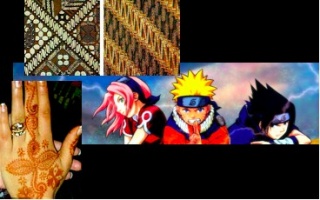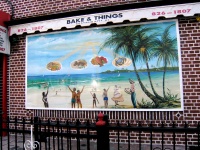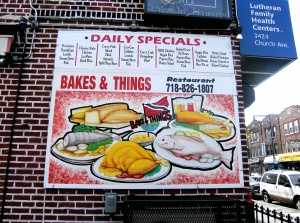Art
From Seminar 2: The Peopling of New York City
Contents |
Overview
Art is used as a very effective tool to compliment certain cultures. Batik of Indonesia, Anime of Japan, Hena designs in India, etc, are forms of art that are so singular and prominent to each country. These images have all become almost representative elements of these countries. While art has provided richness to many cultures, it unfortunately has also produced a side-effect called stereotype. People walk into neighborhoods of a distinct culture and expect to see various forms of art reflecting that culture in a unique way. In other words, art has become a tool for enjoyment and satisfaction in the eyes of "tourists." In Flatbush, a predominantly residential area, no such "tourist" expectations can be met. Houses look like houses, stores look like stores, and people are wearing normal clothes. However, when looked at carefully, there are hints of visual art throughout the neighborhood such as T-shirts that contain cultural implications, murals of menus outside of restaurants, exotic and colorful signs and store fronts, careful graffiti, etc. The visual art piece, which are all commercial art in this particular study, and its impact on those who come across it show transnationalism; each of them communicate stories of the islands in the very place of Flatbush, acting as strong bonds that connect immigrants and residents of different spaces of Flatbush and the Caribbean simultaneously.The Traditional Caribbean Art
"The job of the artist as a prime cultural agent is often seen to be the same as that of the priest or guru--viz "to guide individual life back into collective life, the personal into the universal [so as] to restore the lost unity of man" or to negate the negation expressed in alienation as another tradition of analysis would put it" (Wilbert 188).
Art is defined to have a specific function in the West Indies; it is not a simply aesthetic aid, but also an element to draw people together, and to express cultural as well as communal harmony in the society. Accordingly, Caribbean Art contains themes such as history, memory, politics, myth, religion, and popular culture--themes that are deeply enrooted in daily lives. Caribbean Art has been under the umbrella of 'Black Art' and even 'tribal art,' in the past. However, art and artists in the Caribbeans have become more prominent since the 20th century, and many art museums have either held exhibitions of contemporary Caribbean art, or are eager to collect such pieces.
The Non-tradition, Commercial Art and Graphic Design in Flatbush
When visual art is defined to be something that exists in everyday in permanent form made through creative process, it can be found more easily than expected. Frankly, Flatbush does not have people wrapped in exotic garments of the islands or any other obvious forms of art. However, on the walls of the stores and in the corners of the street where T-shirts are being sold and created, art can be found, along with strong affective transnational tied. In other words, commercial art and graphic design prevalent throughout the neighborhood not only are used as items to sell, but also as symbols and manifestations of transnationalism that is able to embrace the immigrants in Flatbush and the nations they came from--commercial art tkaes another layer of meaning in Flatbush.
T-Shirts
T-Shirts are other elements that effectively and creatively maintain ties back to where everyone came from. Throughout the neighborhood, there are a number of T-shirt print stores, spray paint stores, T-shirt designing stores, and religious shops that sell T-shirts related to Rastafarianism, all expressing distinct cultures and values of the West Indies. Similar to 'purer' art mentioned previously, the T-shirts contain themes of history, memory, politics, myth, religion, and popular culture. Many T-shirts show patriotism, with flags and colors. Often the inside jokes on the T-shirts come from Caribbean cultures, which to foreigners, may appear inappropriate. The shirts are not only for fashionable reasons, but according to an owner of a T-shirt stand, function as "patriotic identification" as well as "West Indian identification." While wearing a certain country's T-shirt tell the others that the one wearing comes from a specific island in the Caribbeans, it also communicates almost "family-like" ties to one another that come from West Indies.
Murals
People of Flatbush have creatively integrated commercial with art, and thus have come up with mural advertisements. While there are full menus drawn onto the walls with elaborate pictures of the cuisine and flags of the countries that the cuisines represent, there are murals of beaches and palmtrees that might remind one of one's home, and thus attracting the customers emotively. Murals, although is used for commercial reasons outside of a restaurant, and one might think do not have artistic merits, appeal to patriotism, memories and values of West Indians, creating and maintaining transparent yet very strong ties to the countries they came from. West Indians have come to incorporate their heritage to the every aspect of life.Store Fronts and Signs
Stores in Flatbush often have interesting signs, color schemes and designs that appeal strongly to the national ties that an immigrant may have. Western Union, for instance, is painted in blue and yellow inside, and with the interior that many of the customers are familiar with from back home, provide a comfortable and cozy environment while they momentarily connect back to their homes through businesses such as money transfer , etc. Flags are most common design among many stores, that tell about the cultural identity of the store, as well as its relationship to the other West Indian Islands.Conclusion
I have to admit that in the beginning of the research, I expected to find Flatbush more "artsy," or richer in the context of visual world, simply because of my faulty perception that anything cultural is exotic, colorful, and thus artistic. However, the study has helped me to see beyond the superficial and glossy definition of culture; culture does not have to resonate physical form of art. The usage of art as Commercial Art, reflected through T-shirts, murals and store fronts, is significant tool of transnationalism. In this case, transnationalism is neither an economic movement or a political issue, but an emotive process that appeals and touches each immigrant's ties to back home simultaneously with their responsibilities and lifestyles in Flatbush, and help them maintain it through integration of art into every aspect of daily lives.Works Cited
Wilbert, Johannes. 1979. Caribbean Cultural Identity: the case of Jamaica. Los Angeles: Center for Afro-American Studies and UCLA LAtin American Center Publcations.
Edmondson, Belinda. 1994. Race, Tradition, and the Construction of the Caribbean Aesthetic. New Literary History 25(1): 109-120.
Foner, Nancy,ed. 2001. Islands in the City: West Indian Migration to New York. Berkeley: University of California Press.
http://www.princetonol.com/groups/iad/lessons/middle/quotes.htm
http://dictionary.reference.com/browse/visual%20art



